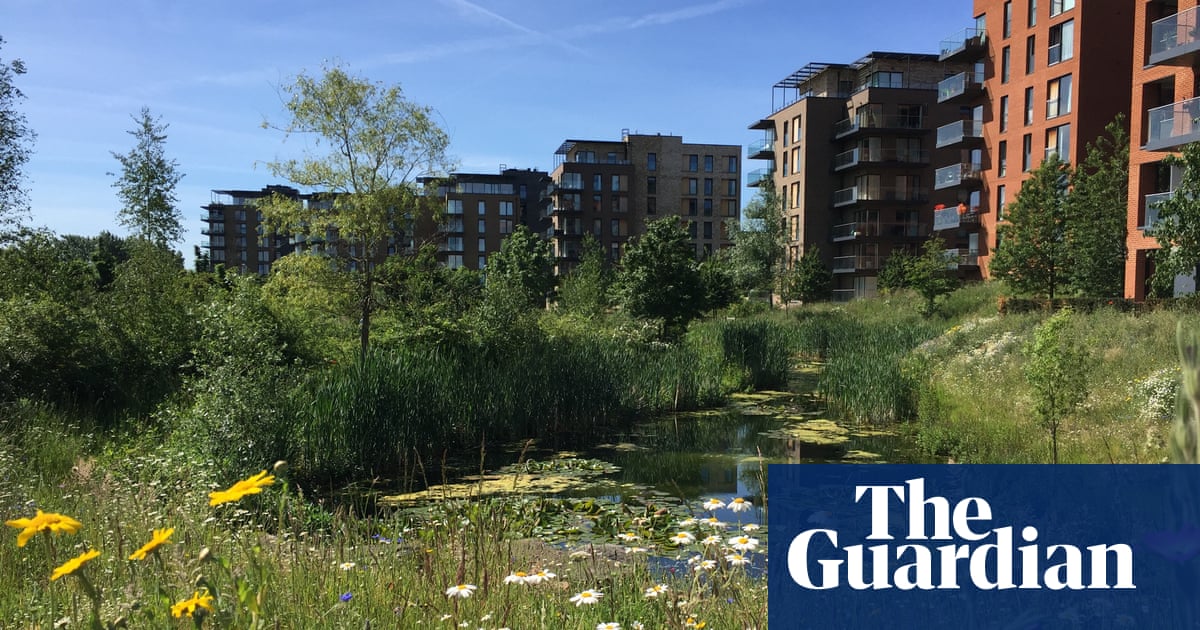Photo credit: www.theguardian.com
A New Era for Housing Development: Integrating Nature in Kidbrooke Village
On a recent spring morning, the Kidbrooke Village housing development in Greenwich offers a serene ambiance characterized by melodious birdsong and the sweet fragrance of blossoms. The gentle honking of geese can be heard in the background, creating a tranquil setting.
This area was previously known as the Ferrier estate, a postwar housing complex that met its end in 2009 as part of a revitalization initiative for the region.
Gone are the stark, grey concrete structures, replaced by warm redbrick buildings that form a “green corridor,” connecting Sutcliffe Park to the south with the nature reserves at Kidbrooke Green and the London Wildlife Trust’s Birdbrook in the north. Many residences boast views of newly created ponds and enhanced wetlands along the River Quaggy, a site that previously faced flooding risks endangering local properties and businesses. Unlike other developers who have faced setbacks due to insufficient wildlife surveys, this project has effectively integrated nature into its design, featuring bat boxes on trees and newt habitats adjacent to apartment buildings.
The thoughtfully designed blue and green spaces interspersed among the flats include a children’s playground and seating areas overlooking the wetlands. With the arrival of summer, the ponds brim with reeds, inviting sightings of reed buntings and kingfishers. During a recent visit, the area was bustling with residents enjoying the pleasant day.
Concerns surrounding wildlife preservation, such as those for newts and bats, often hinder housing initiatives, as noted by prominent politicians like Keir Starmer and Rachel Reeves. However, Kidbrooke Village stands as a successful case where 5,000 new homes coexist harmoniously with natural habitats. Wildlife trusts have engaged collaboratively with developers to ensure that the construction of quality homes does not come at the expense of the environment.
Other successful wildlife trust projects include Trumpington Meadows in Cambridgeshire, which has transformed a former potato field into a vibrant ecosystem home to blue butterflies and other wildlife. Priest Hill near Epsom has repurposed previously neglected playing fields into a mixed-use development that combines residential housing with proximity to a nature reserve. Furthermore, Tadpole Garden Village in Wiltshire promises to offer substantial green space along with nearly 2,000 new homes.
David Mooney, the chief executive of the London Wildlife Trust, emphasizes the nature-based approach taken in Kidbrooke Village: “Our initial role was to address the flooding issues of the River Quaggy. We established connections to a floodplain and devised sustainable urban drainage systems, then collaborated with Berkeley Homes to build flats surrounding the newly formed wetlands.”
Legislation currently under consideration in parliament may dilute some environmental safeguards, making it easier for developers to pursue projects without adequate regard for natural ecosystems.
“The government is creating a misleading divide between housing and nature,” Mooney argues. “For years, we have successfully partnered with housing developers. While some prioritize profit at the expense of the environment, responsible developers recognize that integrating nature enhances the well-being of residents, reduces flooding risks, offers shade, and yields numerous benefits.”
Creating and maintaining wild spaces also cuts costs for developers, as these areas require less frequent maintenance compared to manicured lawns. During the summer, the meadows will transform into a thriving wildflower habitat.
Referring to the now-rejuvenated landscape, Mooney points out: “This area was once concrete wasteland. To those who wish to develop it for housing, what’s the benefit? People cherish the accessibility to nature.”
The development not only supports newt populations but also enriches the lives of residents. “Who wouldn’t want to see wildlife up close? The presence of nature, such as dragonflies hovering by their windows, creates a strong connection with the environment,” he adds. Community engagement and volunteer efforts are now an integral part of maintaining this space, even leading to plans for a nature pavilion.
Features accommodating wildlife have been incorporated into the architectural design of the estate, including bat boxes and specially designed bricks for nesting birds. “These adaptations are not only feasible but can also be accomplished at low cost,” Mooney explains.
Additionally, the rubble from the former structure has been repurposed into nature mounds, providing new spaces for gatherings and picnics while supporting wildflowers.
Mooney expresses concern that government changes may limit the potential for future developments like Kidbrooke Village, creating a trend of housing projects lacking ecological consideration. He warns, “Some developers are eager to exploit these policy changes, prioritizing profit over environmental stewardship and quality of life for future residents.”
In summary, the Kidbrooke Village project represents a forward-thinking model of how housing developments can successfully coexist with natural environments, illustrating that thoughtful infrastructure planning can enhance both ecological and community well-being.
Source
www.theguardian.com

